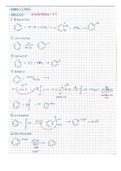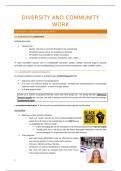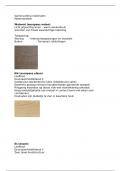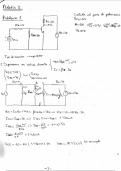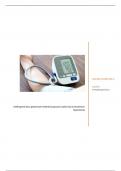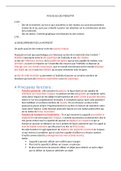RELATIONSHIP BETWEEN SELF-EFFICACY AND SELF-ESTEEM 1
The Relationship Between Self-efficacy for Learning and Performance
and Self-esteem Among University Students
Cedric Badjeck
Student No.26461177
Shahjan Omar, Tutor
Group 10
Statistics I
16-12-2020
,RELATIONSHIP BETWEEN SELF-EFFICACY AND SELF-ESTEEM 2
Correlational Study Between Academic Self-efficacy and Self-esteem in Students
Beliefs are subjective convictions that guide behavior toward a range of actions which
individuals regard as beneficial. Self-esteem and self-efficacy are two of the major
components that guide students toward achieving satisfying academic performances (Lane,
Lane, and Kriprianou, 2010). Self-efficacy is defined as an individual’s belief in his/her
abilities (Bandura, 1977) and self-esteem is defined as the subjective evaluation of oneself
(Kohn, 1994).
The purposes of this study were (a) to determine whether academic self-efficacy could
be predicted by self-esteem, and (b) whether there was a gender difference in self-efficacy.
More recently Lane et al, (2010) reported a significant association between self-efficacy and
self-esteem. The explanation for this association is that the higher the level of self-esteem the
more subjects perceived themselves as efficient in executing a task (Lane, Lane, and
Kriprianou, 2010). Regarding gender difference, Nissen(2019) has found a significant result
in self-efficacy.
The present study sought to determine whether academic self-efficacy could be
predicted by self-esteem and whether there was a gender difference regarding self-efficacy.
There were two hypotheses (1) that there will be a statistically significant correlation between
academic self-efficacy scores and self-esteem score in students and (2) that there will be
significant difference regarding self-efficacy scores between male and female students.
Methods
Participants
Subjects, 250 in total, comprised all first-year students at the VU, Amsterdam. Subjects
included 11.9% male and 88.1% female, age ranging from 17 to 55 years (M = 22.65, SD =
5.72). We recruited by convenience, some (22.6%) study psychology, whereabout (39.5%)
pedagogy, and (39.7%) studied PMC(pre-master) . The level of education was WO (0.4%),
,RELATIONSHIP BETWEEN SELF-EFFICACY AND SELF-ESTEEM 3
followed by HBO (39.5%), then HBO-propedeuse (14.0%), next VWO (37.9%) and (8.2%)
reported other level. In the sample, 79.8% reported following the Dutch track, while 20.2%
the English track
Materials
The MSLQ (Duncan & McKeachie, 2015) questionnaire was used to measure the student’s
self-efficacy level. The items were generated corresponding to a 7-point Likert
scale, the items comprising this scale evaluates two aspects of expectancy: expectancy for
success and self-efficacy with subjects stating how relevant each item was from not at all true
of me (1) to very true of me (7). Scales were constructed by taking the mean of the items that
make up that scale. To measure self-esteem, subjects answered 10 questions on a 7-point
Likert scale from not at all true of me (1) to very true of me (7) about their self-esteem Using
a linear regression analysis, we investigated how well specific variables on the Rosenberg
Self Esteem Scale (Rosenberg, 1965) relate to self-esteem as the independent variable
predicted academic self-efficacy. To asses gender difference regarding self-efficacy, we
conducted an independent sample t-test.
Procedure
Data was collected using an online questionnaire which was administered during the
workgroups. Participation was conducted for the final assignment of Statistics in the second
period of the first year. Participation was not compulsory. Students answered questions about
their self-efficacy during class and they were asked to gauge their self-esteem. Subjects gave
their consent and the ones who felt like not filling the survey were free to withdraw at any
moment.
Results
Using IBM SPSS Statistics version 27.0, we performed a linear regression analysis to
assess whether self-efficacy could be predicted by self-esteem. The data collect yielded the
, RELATIONSHIP BETWEEN SELF-EFFICACY AND SELF-ESTEEM 4
following statistics: The average level of self-efficacy was 4.31, (SD = 1.14) and of self-
esteem 5.032, (SD = 1.12). There was a significant positive relationship between academic
self-efficacy and self-esteem b = 0.183, 95% CI [0.06, 0.31], t = 2.81, p < 0.005. The
computed explained variance was R² = 0.032.
To compare levels of self-efficacity in male and female students an independent-
samples t-test was conducted. A significant difference between the two groups could be found
on self-efficacity t(243) = 3.02, p< 0.003,95% CI [0.23, 1.1]. The average score for man was
4.91, (SD = 1.13) and for woman 4.24 (SD = 1.12).
Discussion
The aims of this study were (a) to investigate the interaction between self-efficacity and self-
esteem, in other to determine whether academic self-efficacy could be predicted by self-
esteem and (b) whether there was a difference in gender regarding self-efficacy
The results of our study have indicated a moderately positive relationship between academic
self-efficacity and self-esteem. These findings fall together with the research by (Lane, Lane,
and Kriprianou,2010), which found that high scores of self-efficacies are associated with high
self-esteem scores. Males in this study indicated to have significantly higher self-efficacy
scores than females. This is not consistent with the research by 1999) as self-efficacy had
Thus, taken together, our findings entirely corroborate with our expectations and predictions.
We had to consider some limitations in our study. Participants included only social science
students this could have caused bias in the assessment of personality traits. Social science
students may have been willing to introspect themselves more than other types of students.
This may have caused an overestimation of the importance of effects on self-esteem and self-
efficacy.to improve this further research could be to include students from other programs as
this would be more external valid. Furthermore, self-efficacy, which was evaluated by the
expectancy for success, did not include all factors influencing gender personality traits. Hence
The Relationship Between Self-efficacy for Learning and Performance
and Self-esteem Among University Students
Cedric Badjeck
Student No.26461177
Shahjan Omar, Tutor
Group 10
Statistics I
16-12-2020
,RELATIONSHIP BETWEEN SELF-EFFICACY AND SELF-ESTEEM 2
Correlational Study Between Academic Self-efficacy and Self-esteem in Students
Beliefs are subjective convictions that guide behavior toward a range of actions which
individuals regard as beneficial. Self-esteem and self-efficacy are two of the major
components that guide students toward achieving satisfying academic performances (Lane,
Lane, and Kriprianou, 2010). Self-efficacy is defined as an individual’s belief in his/her
abilities (Bandura, 1977) and self-esteem is defined as the subjective evaluation of oneself
(Kohn, 1994).
The purposes of this study were (a) to determine whether academic self-efficacy could
be predicted by self-esteem, and (b) whether there was a gender difference in self-efficacy.
More recently Lane et al, (2010) reported a significant association between self-efficacy and
self-esteem. The explanation for this association is that the higher the level of self-esteem the
more subjects perceived themselves as efficient in executing a task (Lane, Lane, and
Kriprianou, 2010). Regarding gender difference, Nissen(2019) has found a significant result
in self-efficacy.
The present study sought to determine whether academic self-efficacy could be
predicted by self-esteem and whether there was a gender difference regarding self-efficacy.
There were two hypotheses (1) that there will be a statistically significant correlation between
academic self-efficacy scores and self-esteem score in students and (2) that there will be
significant difference regarding self-efficacy scores between male and female students.
Methods
Participants
Subjects, 250 in total, comprised all first-year students at the VU, Amsterdam. Subjects
included 11.9% male and 88.1% female, age ranging from 17 to 55 years (M = 22.65, SD =
5.72). We recruited by convenience, some (22.6%) study psychology, whereabout (39.5%)
pedagogy, and (39.7%) studied PMC(pre-master) . The level of education was WO (0.4%),
,RELATIONSHIP BETWEEN SELF-EFFICACY AND SELF-ESTEEM 3
followed by HBO (39.5%), then HBO-propedeuse (14.0%), next VWO (37.9%) and (8.2%)
reported other level. In the sample, 79.8% reported following the Dutch track, while 20.2%
the English track
Materials
The MSLQ (Duncan & McKeachie, 2015) questionnaire was used to measure the student’s
self-efficacy level. The items were generated corresponding to a 7-point Likert
scale, the items comprising this scale evaluates two aspects of expectancy: expectancy for
success and self-efficacy with subjects stating how relevant each item was from not at all true
of me (1) to very true of me (7). Scales were constructed by taking the mean of the items that
make up that scale. To measure self-esteem, subjects answered 10 questions on a 7-point
Likert scale from not at all true of me (1) to very true of me (7) about their self-esteem Using
a linear regression analysis, we investigated how well specific variables on the Rosenberg
Self Esteem Scale (Rosenberg, 1965) relate to self-esteem as the independent variable
predicted academic self-efficacy. To asses gender difference regarding self-efficacy, we
conducted an independent sample t-test.
Procedure
Data was collected using an online questionnaire which was administered during the
workgroups. Participation was conducted for the final assignment of Statistics in the second
period of the first year. Participation was not compulsory. Students answered questions about
their self-efficacy during class and they were asked to gauge their self-esteem. Subjects gave
their consent and the ones who felt like not filling the survey were free to withdraw at any
moment.
Results
Using IBM SPSS Statistics version 27.0, we performed a linear regression analysis to
assess whether self-efficacy could be predicted by self-esteem. The data collect yielded the
, RELATIONSHIP BETWEEN SELF-EFFICACY AND SELF-ESTEEM 4
following statistics: The average level of self-efficacy was 4.31, (SD = 1.14) and of self-
esteem 5.032, (SD = 1.12). There was a significant positive relationship between academic
self-efficacy and self-esteem b = 0.183, 95% CI [0.06, 0.31], t = 2.81, p < 0.005. The
computed explained variance was R² = 0.032.
To compare levels of self-efficacity in male and female students an independent-
samples t-test was conducted. A significant difference between the two groups could be found
on self-efficacity t(243) = 3.02, p< 0.003,95% CI [0.23, 1.1]. The average score for man was
4.91, (SD = 1.13) and for woman 4.24 (SD = 1.12).
Discussion
The aims of this study were (a) to investigate the interaction between self-efficacity and self-
esteem, in other to determine whether academic self-efficacy could be predicted by self-
esteem and (b) whether there was a difference in gender regarding self-efficacy
The results of our study have indicated a moderately positive relationship between academic
self-efficacity and self-esteem. These findings fall together with the research by (Lane, Lane,
and Kriprianou,2010), which found that high scores of self-efficacies are associated with high
self-esteem scores. Males in this study indicated to have significantly higher self-efficacy
scores than females. This is not consistent with the research by 1999) as self-efficacy had
Thus, taken together, our findings entirely corroborate with our expectations and predictions.
We had to consider some limitations in our study. Participants included only social science
students this could have caused bias in the assessment of personality traits. Social science
students may have been willing to introspect themselves more than other types of students.
This may have caused an overestimation of the importance of effects on self-esteem and self-
efficacy.to improve this further research could be to include students from other programs as
this would be more external valid. Furthermore, self-efficacy, which was evaluated by the
expectancy for success, did not include all factors influencing gender personality traits. Hence

